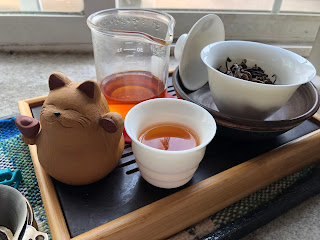Jiang Po Ni Yixing Clay Teapots
Have you ever gotten a teapot because it was absolutely gorgeous, but you didn't know much about the Yixing clay from which it was made?
I saw this Ox Yixing pot on the Yinchen Studio's Instagram and fell in love. It was just before the start of the Lunar New Year of the Ox, so I had to get it. It is made with jiang po ni clay.
I didn't know much about Jiang Po Ni clay, so I set about doing some online research in an afternoon. Here's what I learned from looking at various websites. I've listed the most useful English websites that I found below.
Disclaimers:
- I am not an expert in Yixing teapots. I could be completely wrong in this blog post.
- This article is not meant to be an exhaustive or definitive article on Jiang Po Ni clay pots. It is a collation of information that I have researched. This article is an educational resource to share information. (References to websites are listed below.)
- Copyrights of images belong to their respective owners as listed.
Brief History of Jiang Po Ni
This particular Yixing clay was discovered back in the 1990's. They found the clay while digging into the mountain to build a road between Huanglong Mountain and Qinglong Mountain. Workers found this layer of ore, which people experimented with and found to be good with tea.
The word, Jiang Po Ni (or jiang poni), means downhill clay or lower slope clay since it was found on the lower slope of the mountain. It's also called “Xiangpo Ni” or “Gangpo Ni” (4).
Some websites call it "scarce" or "rare". Others say that this is just hype. I'm not sure which one is more accurate.
Ore Composition
Jiang po ni Yixing ore is a paragentic ore, which is a naturally-occurring mixture of three different kinds of zisha ore --- Hongni (red clay), Zini (purple clay), and Duanni (yellow clay). Mud & Leaves calls it a "Rainbow Ore" (1).
- The resulting clay can look different based on the ratio of these three types of ore.
- The shrink rate differs depending on the ore composition.
Example: Jiang Po Hong Ni Clay (Downhill Red Clay) -- higher concentration of either hongni/zini clay
Image is copyrighted by Nannuoshan
Example: Jiang Po Lu Ni Clay (Downhill Green Clay) -- higher concentration of duanni.
Image is copyrighted by Nannuoshan
Example of both types of clay next to each other:

Figure: Both types of Jiang Po Ni clay.
Image is copyrighted by Global Tea Hut (3)
Clay Firing
The resulting clay can be fired at different temperatures, thus resulting in a slightly different color, depending on the heat. So, you can get different looking types of Jiang Po Ni teaware.
- Example of Jiang Po Hong Ni Clay at different firing temperatures. Notice the very red, almost Zini or dark hongni color at 1180C?

Image is copyrighted by Nannuoshan
- Example of Jiang P Lu Ni Clay at different firing temperatures. There's a slightly reddish tint to the clay.
Image is copyrighted by Nannuoshan (2)
What Kinds of Tea Work with Jiang Po Ni?
- rock tea
- dan cong
- oolong (any highly oxidized oolongs)
- tie guan yin
- green tea
- hei cha/ puerhs
- black tea






Comments
Post a Comment